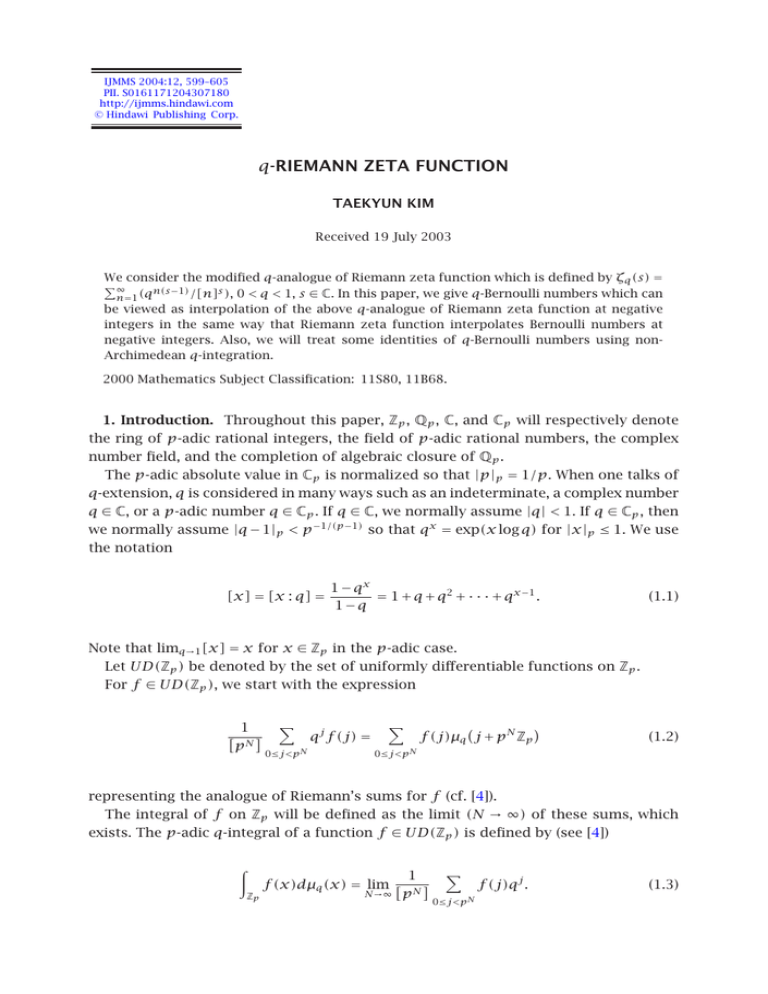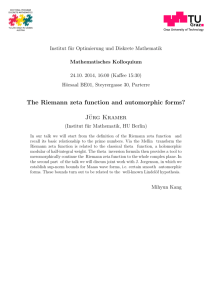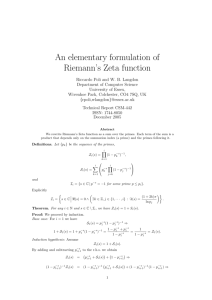q TAEKYUN KIM
advertisement

IJMMS 2004:12, 599–605 PII. S0161171204307180 http://ijmms.hindawi.com © Hindawi Publishing Corp. q-RIEMANN ZETA FUNCTION TAEKYUN KIM Received 19 July 2003 We consider the modified q-analogue of Riemann zeta function which is defined by ζq (s) = ∞ n(s−1) /[n]s ), 0 < q < 1, s ∈ C. In this paper, we give q-Bernoulli numbers which can n=1 (q be viewed as interpolation of the above q-analogue of Riemann zeta function at negative integers in the same way that Riemann zeta function interpolates Bernoulli numbers at negative integers. Also, we will treat some identities of q-Bernoulli numbers using nonArchimedean q-integration. 2000 Mathematics Subject Classification: 11S80, 11B68. 1. Introduction. Throughout this paper, Zp , Qp , C, and Cp will respectively denote the ring of p-adic rational integers, the field of p-adic rational numbers, the complex number field, and the completion of algebraic closure of Qp . The p-adic absolute value in Cp is normalized so that |p|p = 1/p. When one talks of q-extension, q is considered in many ways such as an indeterminate, a complex number q ∈ C, or a p-adic number q ∈ Cp . If q ∈ C, we normally assume |q| < 1. If q ∈ Cp , then we normally assume |q − 1|p < p −1/(p−1) so that qx = exp(x log q) for |x|p ≤ 1. We use the notation [x] = [x : q] = 1 − qx = 1 + q + q2 + · · · + qx−1 . 1−q (1.1) Note that limq→1 [x] = x for x ∈ Zp in the p-adic case. Let U D(Zp ) be denoted by the set of uniformly differentiable functions on Zp . For f ∈ U D(Zp ), we start with the expression 1 pN 0≤j<p N qj f (j) = f (j)µq j + p N Zp (1.2) 0≤j<p N representing the analogue of Riemann’s sums for f (cf. [4]). The integral of f on Zp will be defined as the limit (N → ∞) of these sums, which exists. The p-adic q-integral of a function f ∈ U D(Zp ) is defined by (see [4]) 1 f (x)dµq (x) = lim N N→∞ p Zp 0≤j<p N f (j)qj . (1.3) 600 TAEKYUN KIM For d that is a fixed positive integer with (p, d) = 1, let Z X = Xd = lim , ← dp N Z X1 = Z p , N X∗ = a + dpZp , (1.4) 0<a<dp (a,p)=1 a + dp N Zp = x ∈ X | x ≡ a mod dp N , where a ∈ Z lies in 0 ≤ a < dp N . Let N be the set of positive integers. For m, k ∈ N, the q-Bernoulli polynomials, (−m,k) (x, q), of higher order for the variable x in Cp are defined using p-adic q-integral βm by (cf. [4]) β(−m,k) (x, q) m m ··· = x + x1 + x2 + · · · + xk Zp Zp Zp (1.5) · q−x1 (m+1)−x2 (m+2)−···−xk (m+k) dµq x1 dµq x2 · · · dµq xk . k times Now, we define the q-Bernoulli numbers of higher order as follows (cf. [2, 4, 7]): β(−m,k) (q) = β(−m,k) (0, q). = β(−m,k) m m m (1.6) By (1.5), it is known that (cf. [4]) β(−m,k) m 1 p N −1 = lim k N→∞ p N x1 =0 p N −1 ··· m x1 + · · · + xk q−x1 m−x2 (m+1)+···−xk (m+k−1) xk =0 m m 1 (i − m)(i − m − 1) · · · (i − m − k + 1) (−1)i , = m (1 − q) i=0 i [i − m][i − m − 1] · · · [i − m − k + 1] where m i (1.7) are the binomial coefficients. (−m,k) (k) (k) = Bm , where Bm are ordinary Bernoulli numbers of order k Note that limq→1 βm (cf. [2, 3, 5, 7, 9]). By (1.5) and (1.7), it is easy to see that (x, q) β(−m,1) m m m xi (−m,1) q βi = [x]m−i i i=0 m 1 j −m jx m (−1)j . = q j (1 − q)m j=0 [j − m] (1.8) We modify the q-analogue of Riemann zeta function which is defined in [1] as follows: for q ∈ C with 0 < q < 1, s ∈ C, define ζq (s) = ∞ q(s−1)n . [n]s n=1 (1.9) 601 q-RIEMANN ZETA FUNCTION The numerator ensures the analytic continuation for (s) > 1. In (1.9), we can consider the following problem. “Are there q-Bernoulli numbers which can be viewed as interpolation of ζq (s) at negative integers in the same way that Riemann zeta function interpolates Bernoulli numbers at negative integers?” In this paper, we give the value ζq (−m) for m ∈ N, which is the answer of the above problem, and construct a new complex q-analogue of Hurwitz’s zeta function and q-Lseries. Also, we will treat some interesting identities of q-Bernoulli numbers. (−m,1) 2. Some identities of q-Bernoulli numbers βm with |1 − q|p < p −1/(p−1) . By (1.5), we have β(−n,1) (x, q) = n X . In this section, we assume q ∈ Cp q−(n+1)t [x + t]n dµq (t) = [d]n−1 d−1 q−ni q−(n+1)dx Zp i=0 x +i : qd d n (2.1) dµqd (x). Thus, we have d−1 (x, q) = [d]n−1 β(−n,1) n q−ni β(−n,1) n i=0 x +i d ,q , d (2.2) where d, n are positive integers. If we take x = 0, then we have − n[n]m β(−m,1) [n]β(−m,1) m m n−1 m n m−1 (−m,1) n q = q q−(m−j)k [j]m−k . [n]k βk k k=0 j=1 (2.3) (−m,1) It is easy to see that limq→1 βm (cf. [7]). = Bm , where Bm are ordinary Bernoulli numbers Remark 2.1. By (2.3), note that m−1 n−1 m j m−k . nk Bk n 1 − nm Bm = k k=0 j=1 (−n,1) Let Fq (t) be the generating function of βn ∞ Fq (t) = k=0 as follows: (−k,1) t βk (2.4) k k! . (2.5) By (1.7) and (2.5), we easily see that Fq (t) = − ∞ m=0 m ∞ n=0 q−mn [n]m−1 tm . m! (2.6) 602 TAEKYUN KIM Through differentiating both sides with respect to t in (2.5) and (2.6), and comparing coefficients, we obtain the following proposition. Proposition 2.2. For m > 0, there exists ∞ (−m,1) − (0,1) Moreover, β0 βm m = q−nm [n]m−1 . (2.7) n=1 = (q − 1)/log q. Remark 2.3. Note that Proposition 2.2 is a q-analogue of ζ(1−2m) for any positive integer m. Let χ be a primitive Dirichlet character with conductor f ∈ N. For m ∈ N, we define β(−m,1) m,χ = X q−(m+1)x χ(x)[x]m dµq (x), for m ≥ 0. (2.8) i d ,q . d (2.9) Note that = [d]m−1 β(−m,1) m,χ d−1 χ(i)q−mi β(−m,1) m i=0 3. q-analogs of zeta functions. In this section, we assume q ∈ C with |q| < 1. In [1], the q-analogue of Riemann zeta function was defined by (cf. [1]) ζq∗ (s) = ∞ qns , [n]s n=1 (s) > 0. (3.1) Now, we modify the above q-analogue of Riemann zeta function as follows: for q ∈ C with 0 < |q| < 1, s ∈ C, define ζq (s) = ∞ q(s−1)n . [n]s n=1 (3.2) By (2.5), (2.6), and (2.7), we obtain the following proposition. Proposition 3.1. For m ∈ N, there exists (−m,1) (i) ζq (1 − m) = −βm /m, for m ≥ 1; (ii) ζq (s) having simple pole at s = 1 with residue (q − 1)/log q. By (1.7) and (1.8), we see that β(−n,1) (x, q) = −n n ∞ n−1 −n(k+x) q , [k]qx + [x] k=0 where 0 ≤ x < 1. (3.3) 603 q-RIEMANN ZETA FUNCTION Hence, we can define q-analogue of Hurwitz ζ-function as follows: for s ∈ C, define ζq (s, x) = ∞ q(s−1)(n+x) s . x n=0 [n]q + [x] (3.4) Note that ζq (s, x) has an analytic continuation in C with only one simple pole at s = 1. By (3.3) and (3.4), we have the following theorem. Theorem 3.2. For any positive integer k, there exists (−k,1) ζq (1 − k, x) = − βk (x, q) . k (3.5) Let χ be Dirichlet character with conductor d ∈ N. By (2.9), the generalized q-Bernoulli numbers with χ can be defined by = [d]m−1 β(−m,1) m,χ d−1 χ(i)q−mi β(−m,1) m i=0 i d ,q . d (3.6) For s ∈ C, we define Lq (s, χ) = ∞ χ(n)q(s−1)n . [n]s n=1 (3.7) It is easy to see that Lq (χ, s) = [d]−s a . χ(a)q(s−1)a ζqd s, d a=1 d (3.8) By (3.6), (3.7), and (3.8), we obtain the following theorem. Theorem 3.3. Let k be a positive integer. Then there exists (−k,1) Lq (1 − k, χ) = − βk,χ k . (3.9) Let a and F be integers with 0 < a < F . For s ∈ C, we consider the functions Hq (s, a, F ) as follows: Hq (s, a, F ) = qm(s−1) a −s . = [F ] ζ F s, q [m]s F m≡a(F ), m>0 (3.10) Then we have Hq (1 − n, a, F ) = − where n is any positive integer. [F ]n−1 (−n,1) a F βn ,q , n F (3.11) 604 TAEKYUN KIM Therefore, we obtain the following theorem. Theorem 3.4. Let a and F be integers with 0 < a < F . For s ∈ C, there exists (−n,1) (a/F , qF ); (i) Hq (1 − n, a, F ) = −([F ]n−1 /n)βn (ii) Hq (s, a, F) having a simple pole at s = 1 with residue (1/[F ]F)((qF −1)/log q). In a recent paper, the q-analogue of Riemann zeta function was studied by Cherednik (see [1]). In [1], we can consider the q-Bernoulli numbers which can be viewed as an interpolation of the q-analogue of Riemann zeta function at negative integers. In this paper, we have shown that the q-analogue of zeta function interpolates q-Bernoulli numbers at negative integers in the same way that Riemann zeta function interpolates Bernoulli numbers at negative integers (cf. [2, 5, 7]). Remark 3.5. Let q ∈ Cp with |1−q|p < p −1/(p−1) . Then the p-adic q-gamma function was defined as (see [8]) Γp,q (n) = (−1)n [j]. (3.12) 1≤j<n, (j,p)=1 For all x ∈ Zp , we have Γp,q (x + 1) = p,q (x)Γp,q (x), (3.13) where p,q (x) = −[x] for |x|p = 1, and p,q (x) = −1 for |x|p < 1, (see [8]). By (3.13), we easily see that (cf. [6]) log Γp,q (x + 1) = log p,q (x) + log Γp,q (x). (3.14) By the differentiation of both sides in (3.14), we have (cf. [6]) (x + 1) Γp,q Γp,q (x + 1) = (x) Γp,q Γp,q (x) + (x) p,q p,q (x) . (3.15) By (3.15), we easily see that (cf. [6]) (x) Γp,q Γp,q (x) = x−1 j=1 qj log q Γp,q (1) + . [j] q − 1 Γp,q (1) (3.16) Define Lp,q (x) = x−1 p,q (j) j=0 p,q (j) . (3.17) It is easy to check that Lp,q (1) = 0. By (3.15), we also see that (x) Γp,q Γp,q (x) = Lp,q (x) + (1) Γp,q Γp,q (1) , for x ∈ Zp , (3.18) q-RIEMANN ZETA FUNCTION 605 (x)/p,q (x). By using (3.18) after subwhere Lp,q (x) denotes the indefinite sum of p,q stituting x = 1, we obtain Lp,q (1) = 0. The classical Euler constant was known as γ = (1)/Γp,q (1) −Γ (1)/Γ (1). In [8], Koblitz defined the p-adic q-Euler constant γp,q = −Γp,q (cf. [6, 8]). By using (3.16) and the congruence of Andrews (cf. [3]), we obtain the following congruence: q−1 log q (p) Γp,q Γp,q (p) − γp,q qj p −1 ≡ (q − 1) mod[p] . [j] 2 j=1 p−1 = (3.19) Acknowledgments. The author expresses his gratitude to the referees for their valuable suggestions and comments. This work was supported by the Korea Research Foundation Grant (KRF-2002-050-C00001). References [1] [2] [3] [4] [5] [6] [7] [8] [9] I. Cherednik, On q-analogues of Riemann’s zeta function, Selecta Math. (N.S.) 7 (2001), no. 4, 447–491. T. Kim, On explicit formulas of p-adic q-L-functions, Kyushu J. Math. 48 (1994), no. 1, 73–86. , On p-adic q-L-functions and sums of powers, Discrete Math. 252 (2002), no. 1–3, 179–187. , q-Volkenborn integration, Russ. J. Math. Phys. 9 (2002), no. 3, 288–299. , Non-archimedean q-integrals associated with multiple Changhee q-Bernoulli polynomials, Russ. J. Math. Phys. 10 (2003), 91–98. T. Kim, L. C. Jang, K-H. Koh, and I.-S. Pyung, A note on analogue of Γ -functions, Proceedings of the Conference on 5th Transcendental Number Theory, vol. 5, no. 1, Gakushuin University, Tokyo, 1997, pp. 37–44. T. Kim and S.-H. Rim, Generalized Carlitz’s q-Bernoulli numbers in the p-adic number field, Adv. Stud. Contemp. Math. (Pusan) 2 (2000), 9–19. N. Koblitz, q-extension of the p-adic gamma function, Trans. Amer. Math. Soc. 260 (1980), no. 2, 449–457. Q.-M. Luo, Z.-L. Wei, and F. Qi, Lower and upper bounds of ζ(3), Adv. Stud. Contemp. Math. (Kyungshang) 6 (2003), no. 1, 47–51. Taekyun Kim: Institute of Science Education, Kongju National University, Kongju 314-701, Korea E-mail address: tkim@kongju.ac.kr









